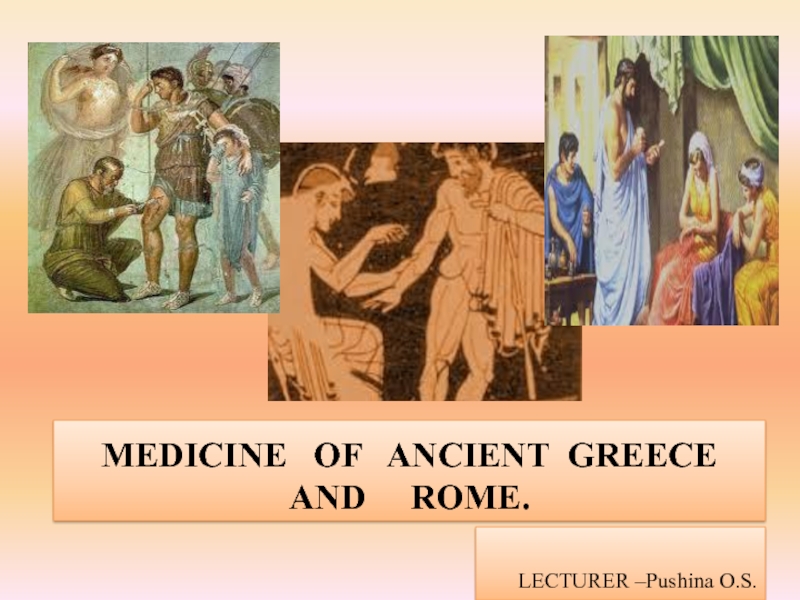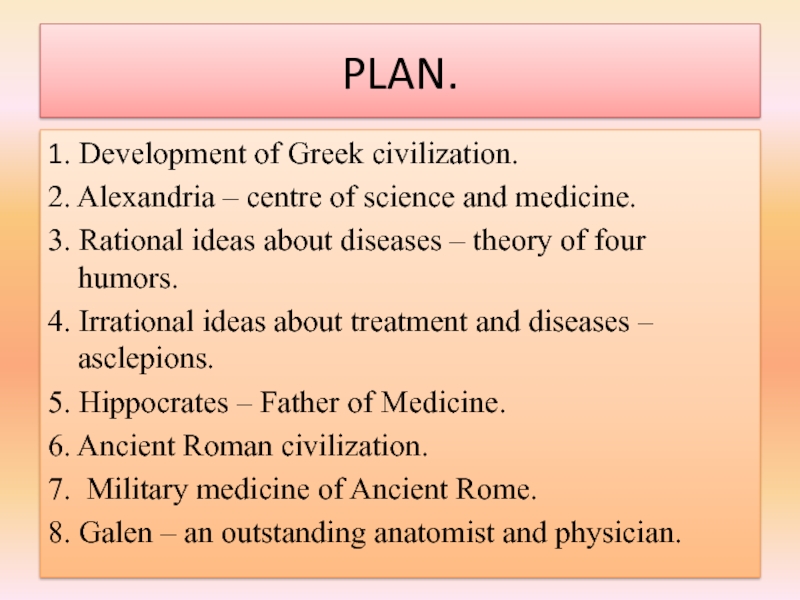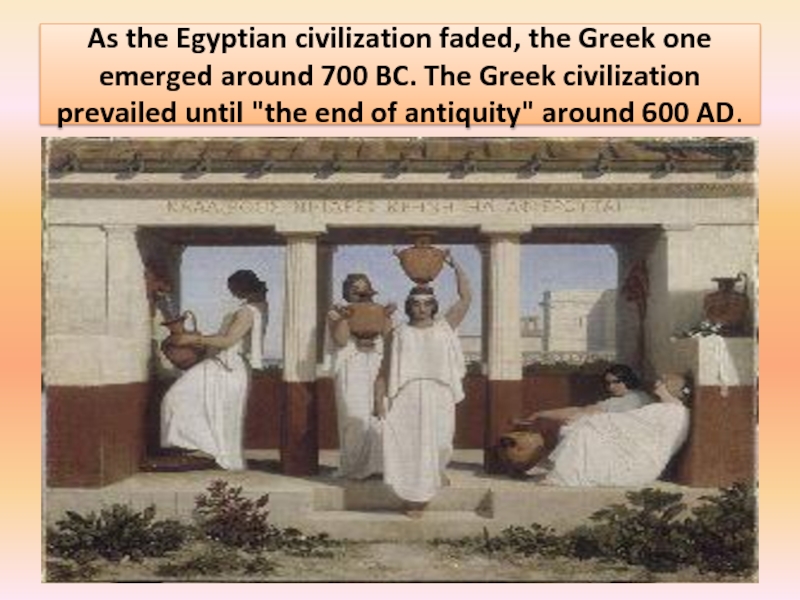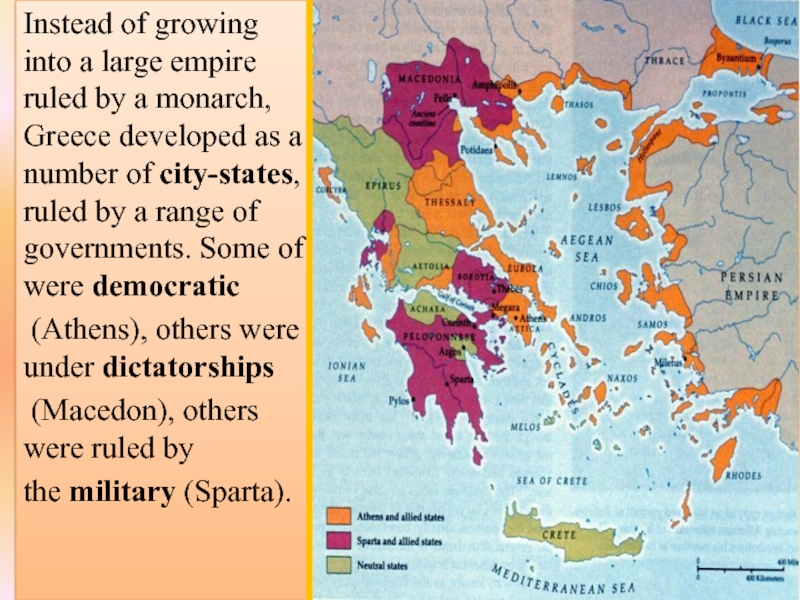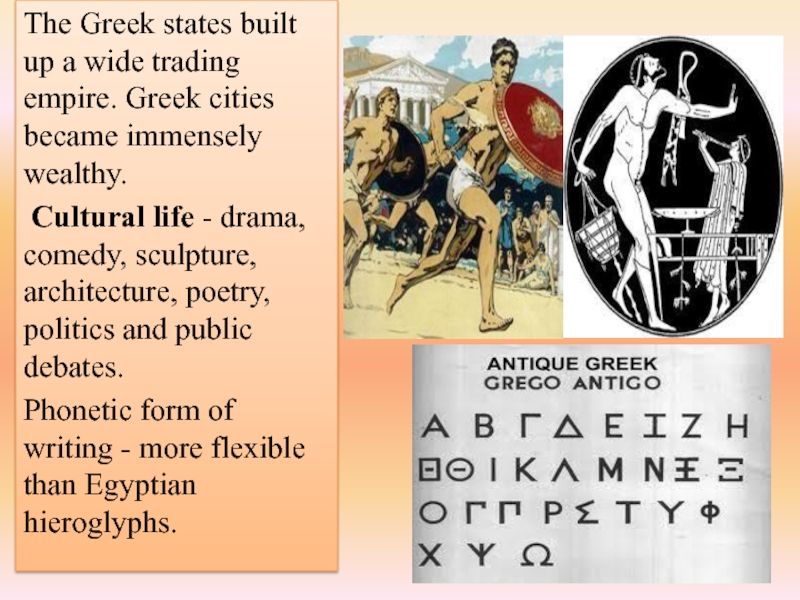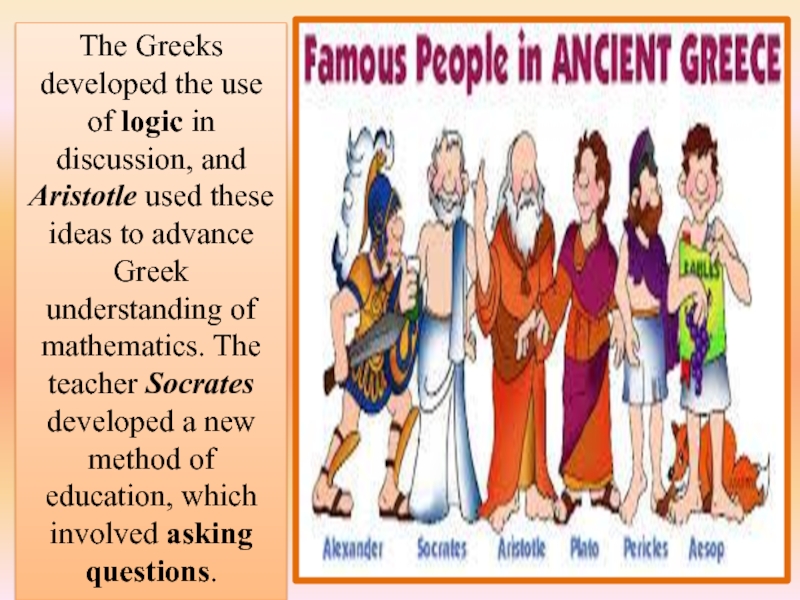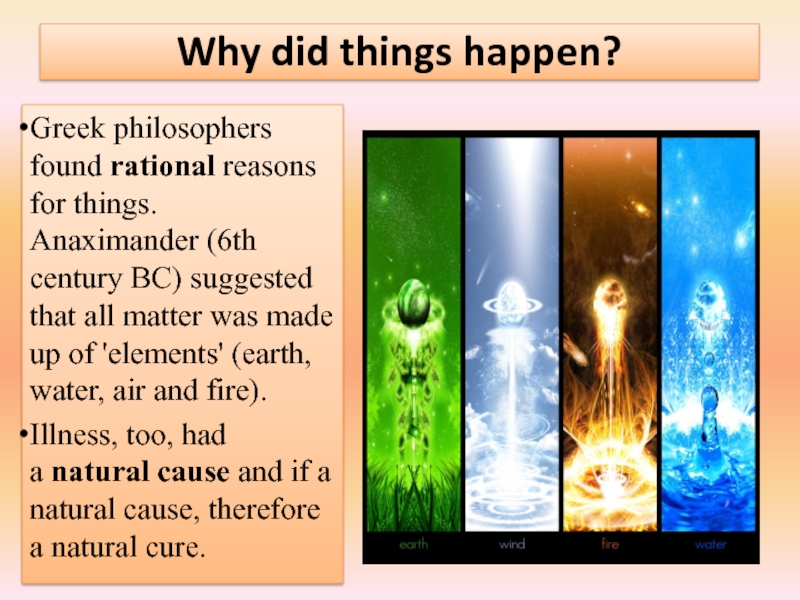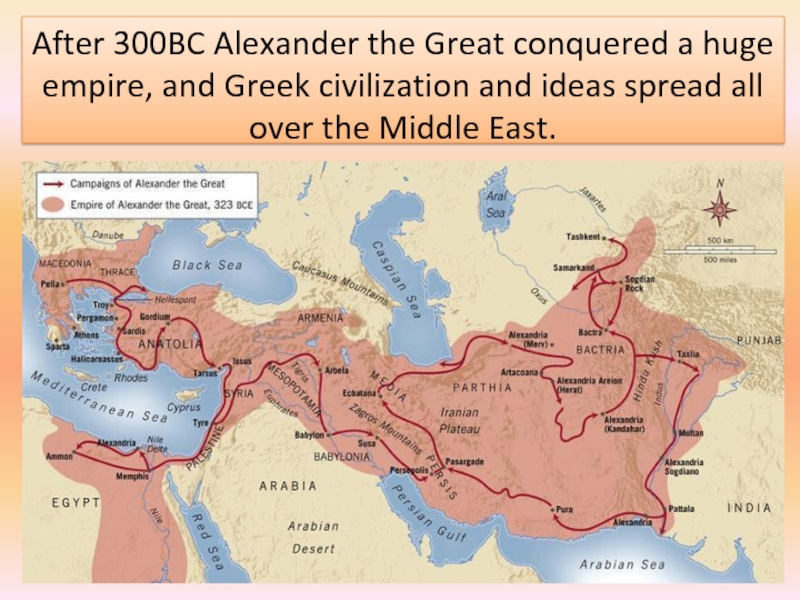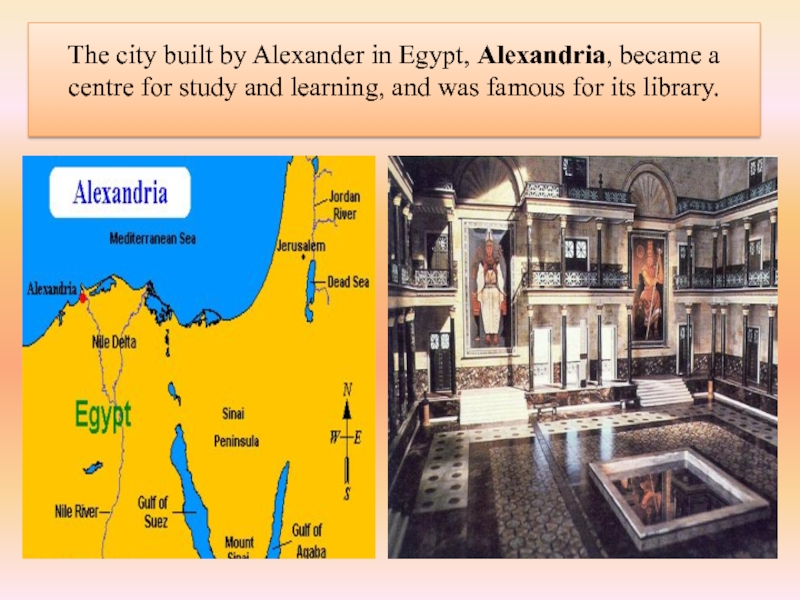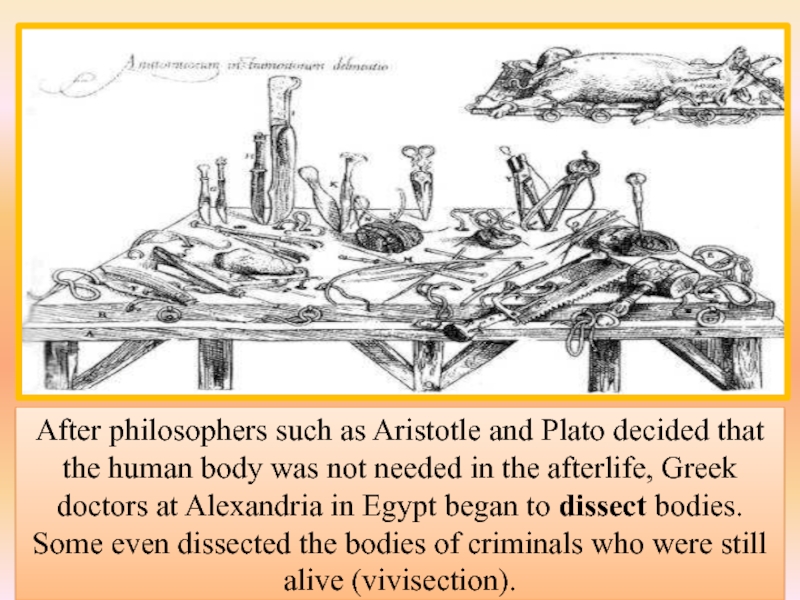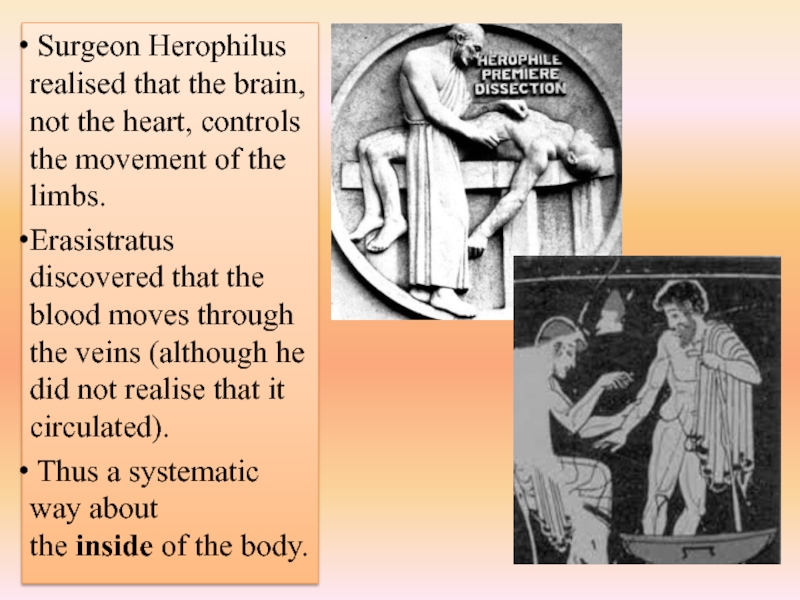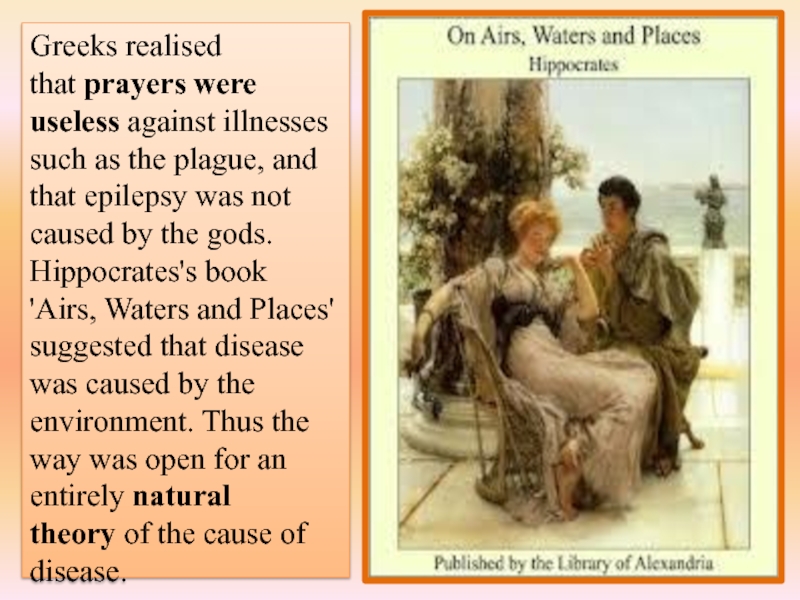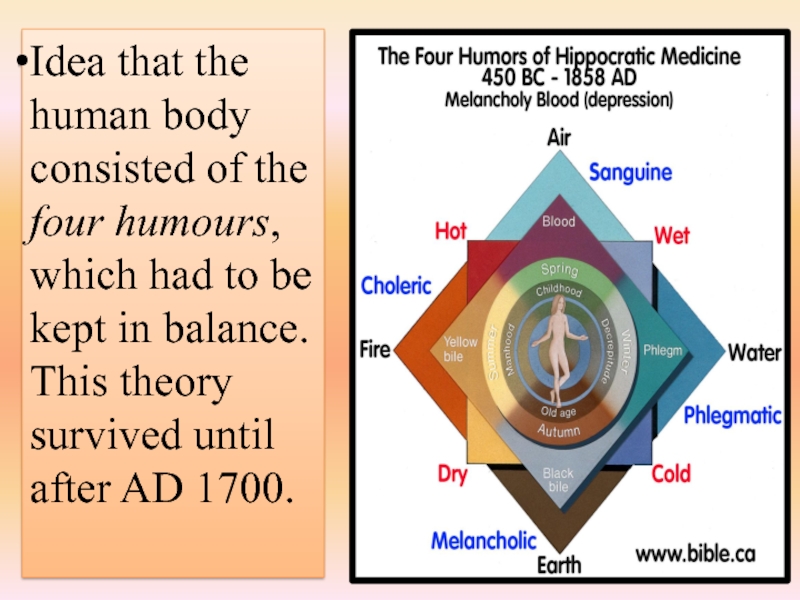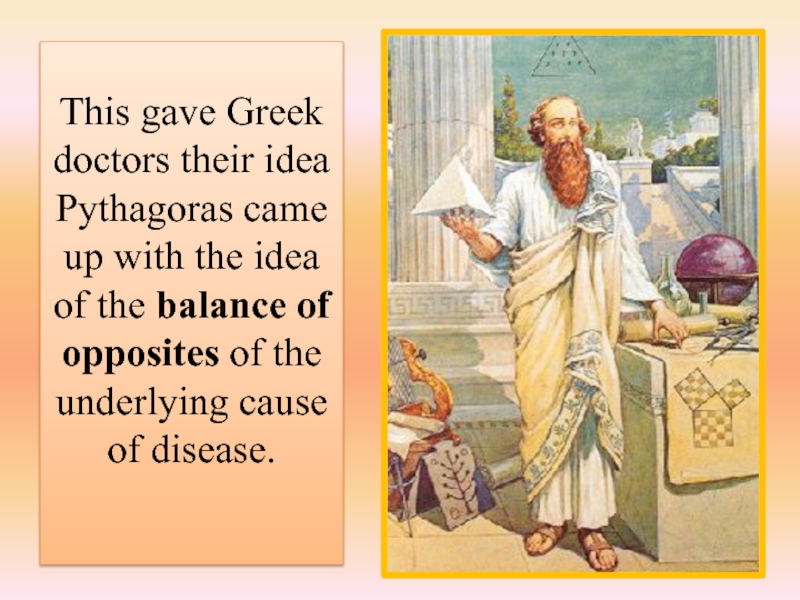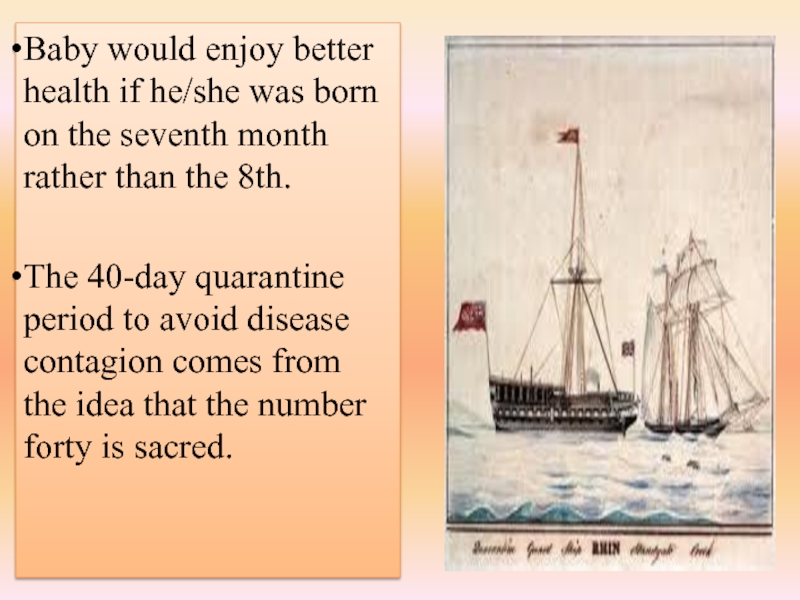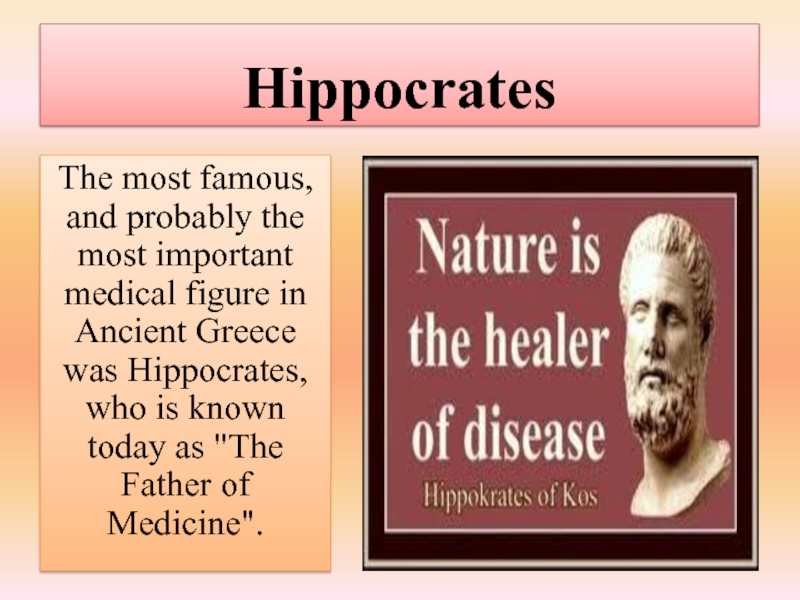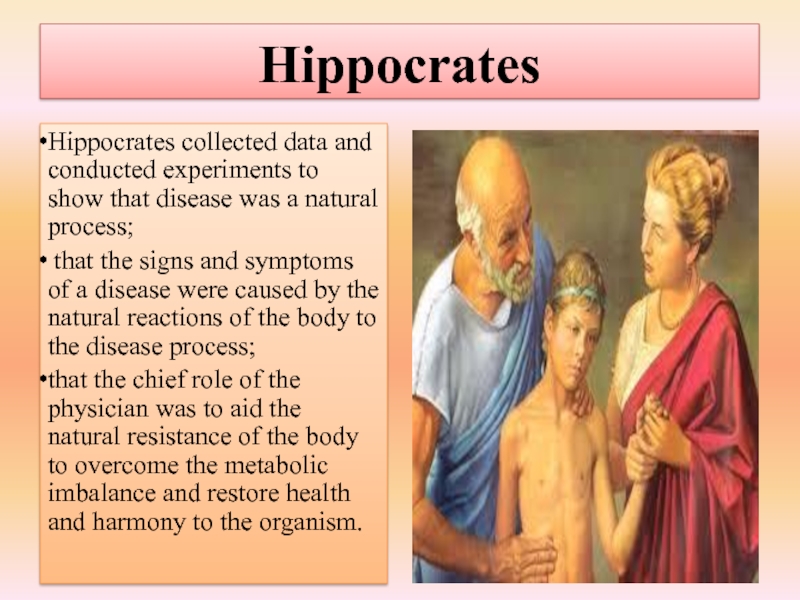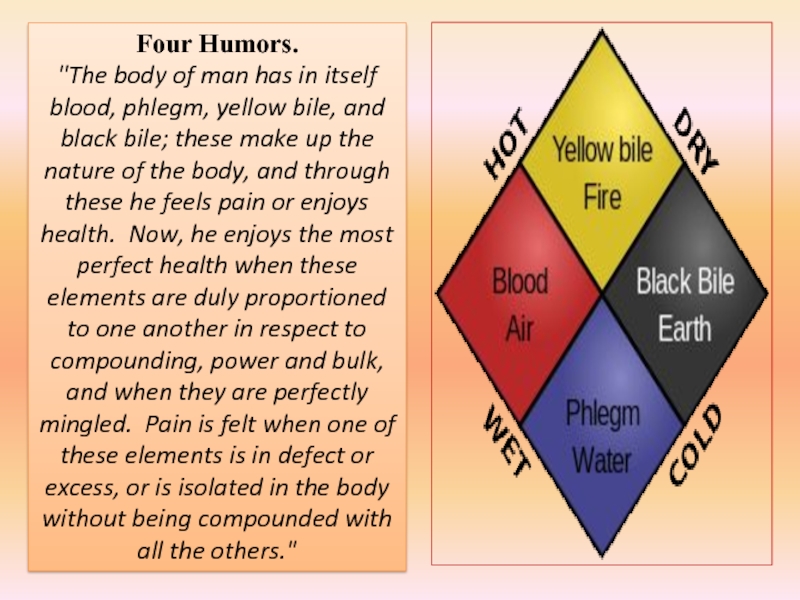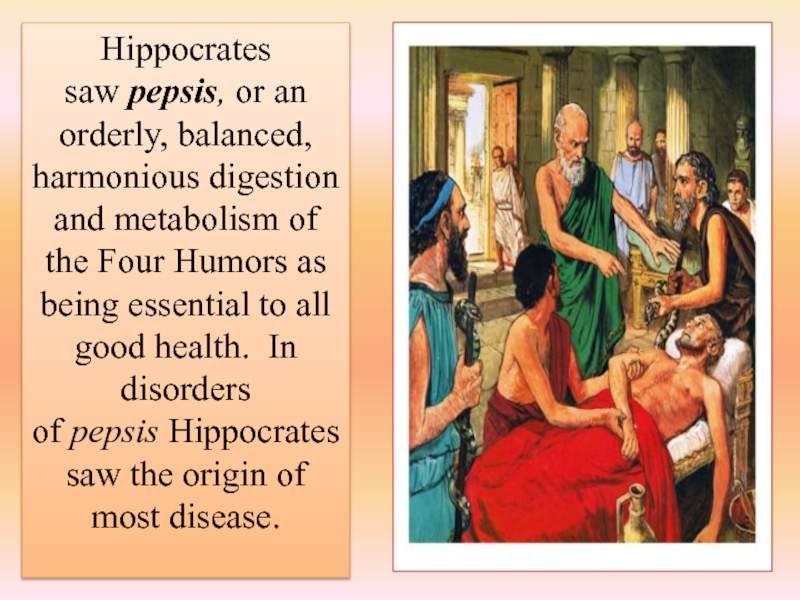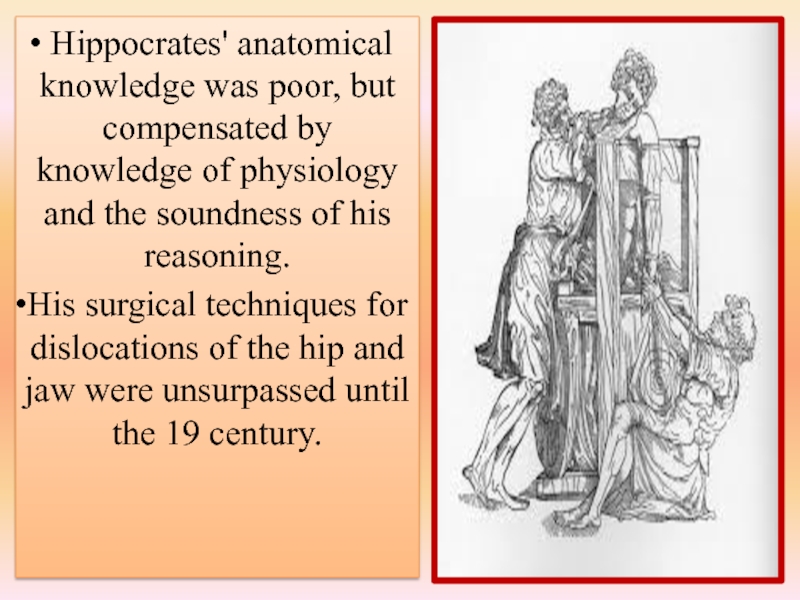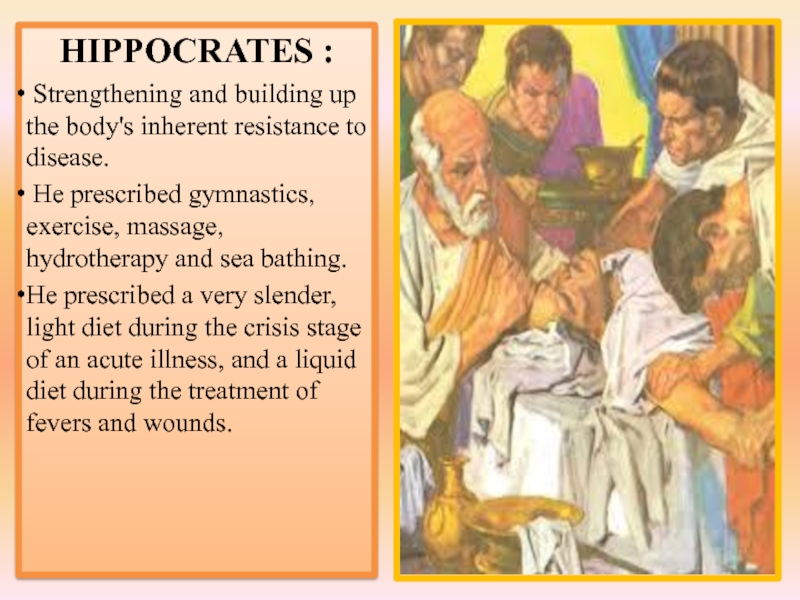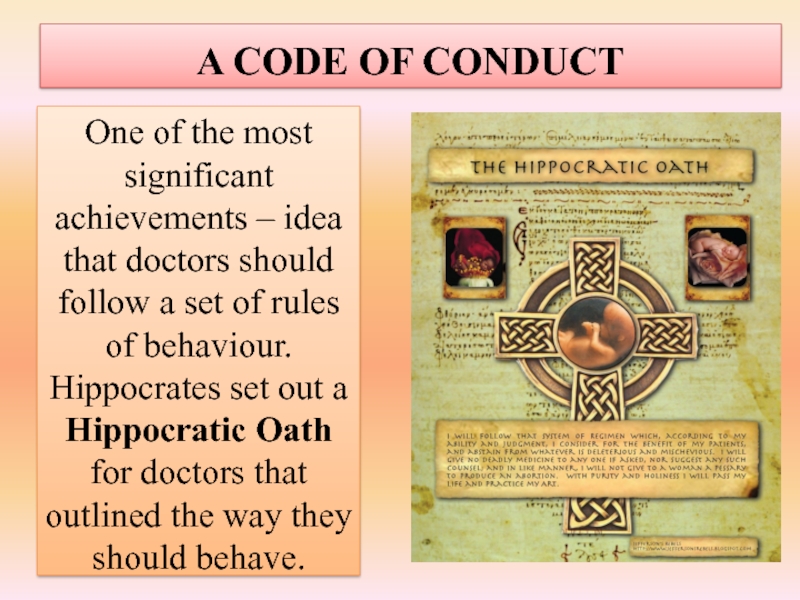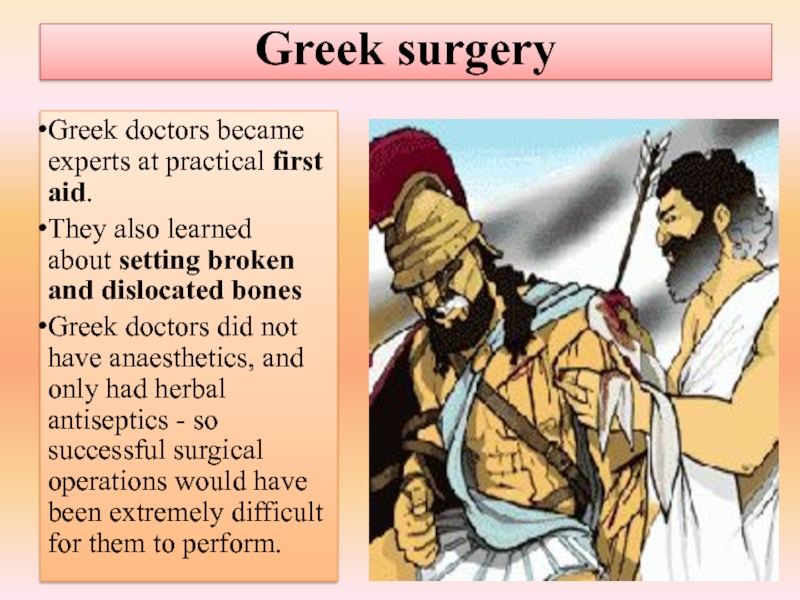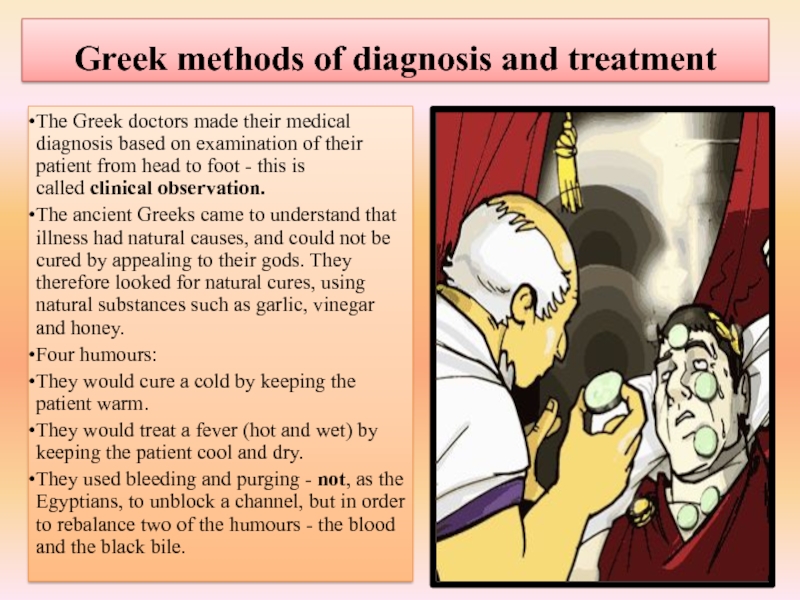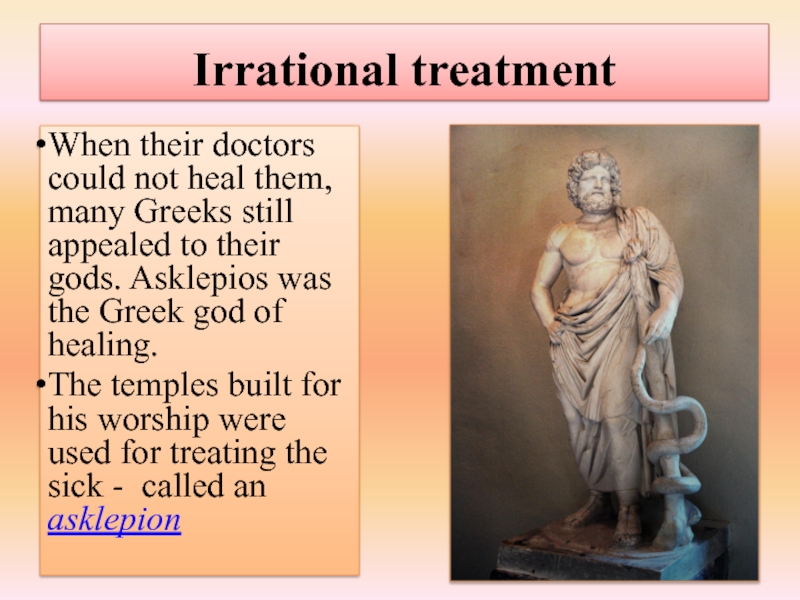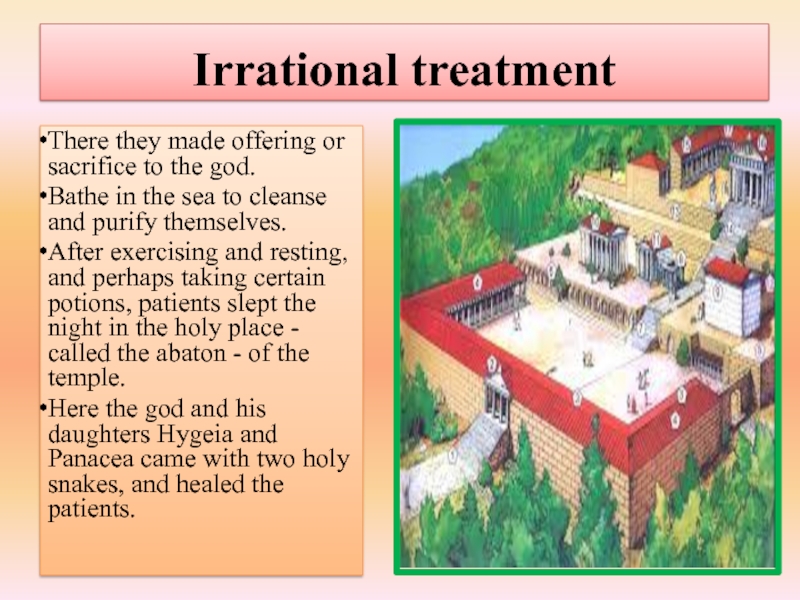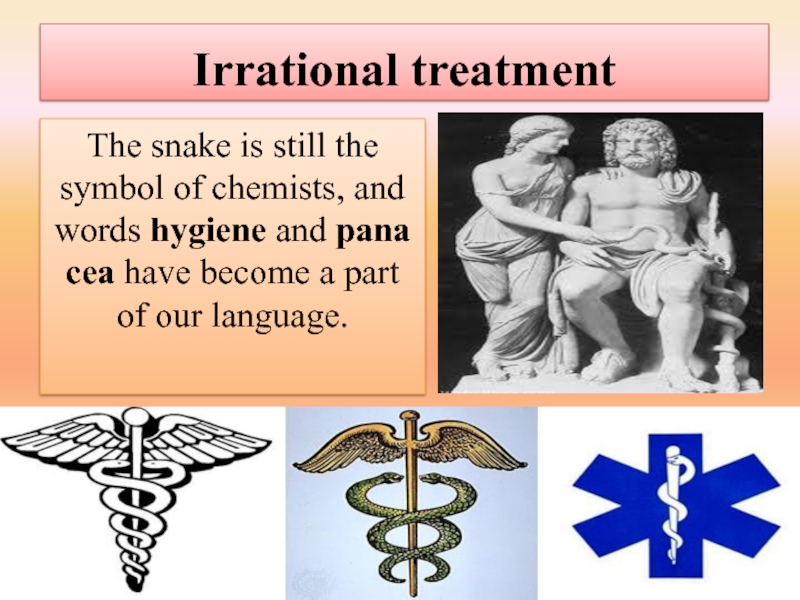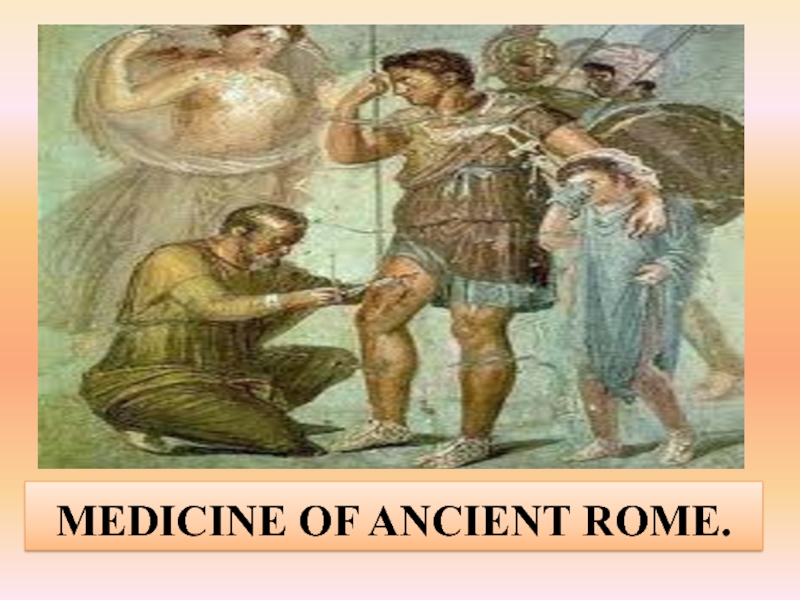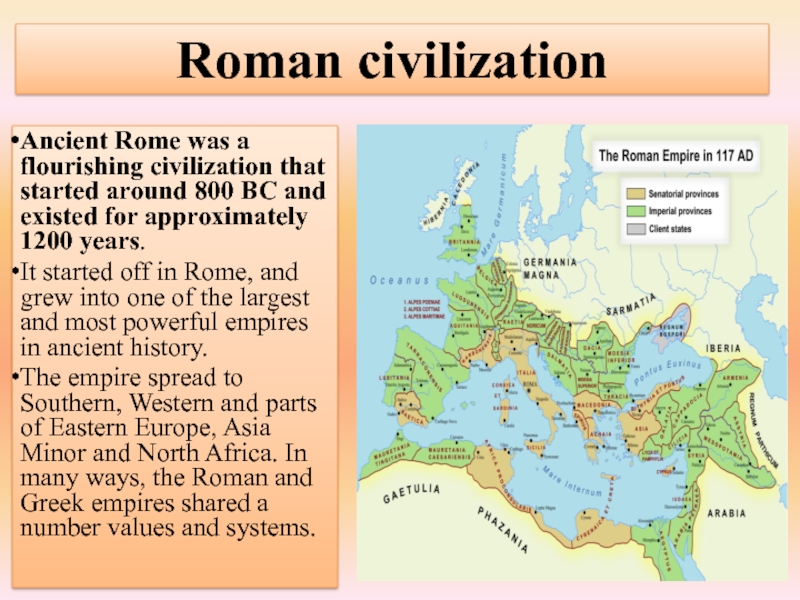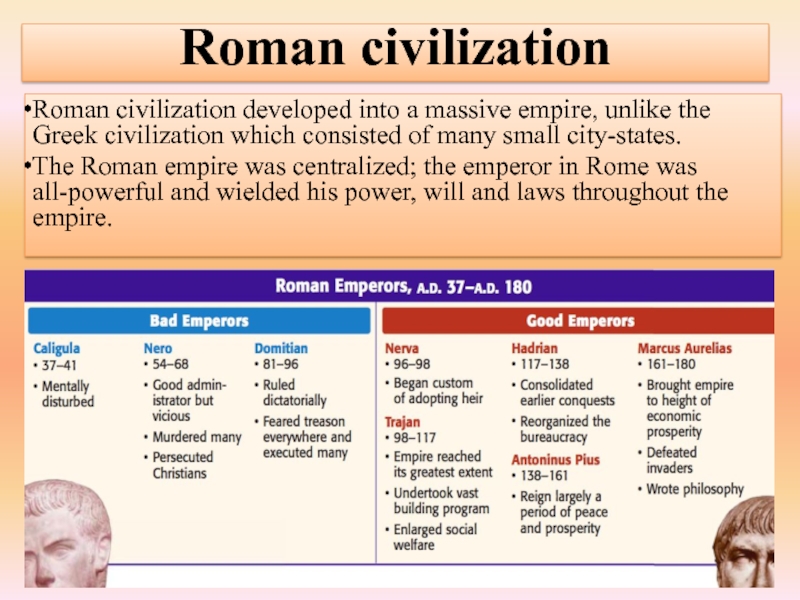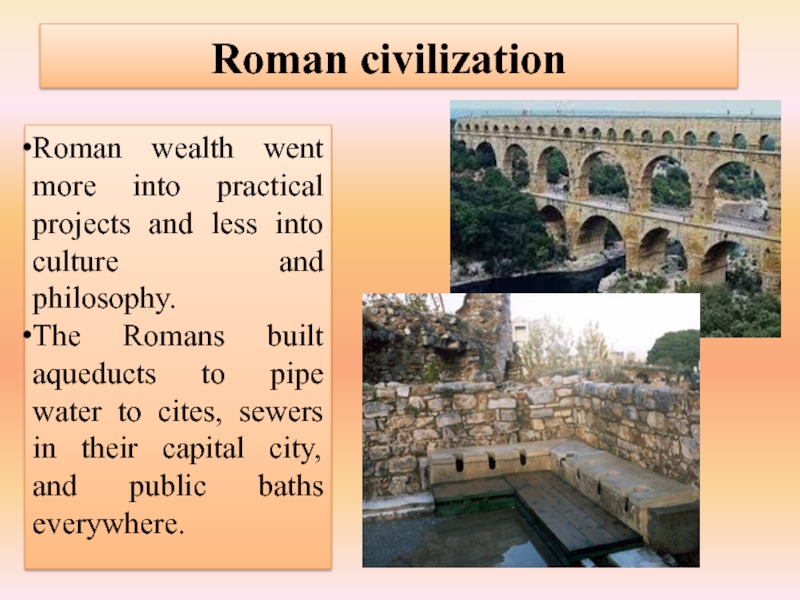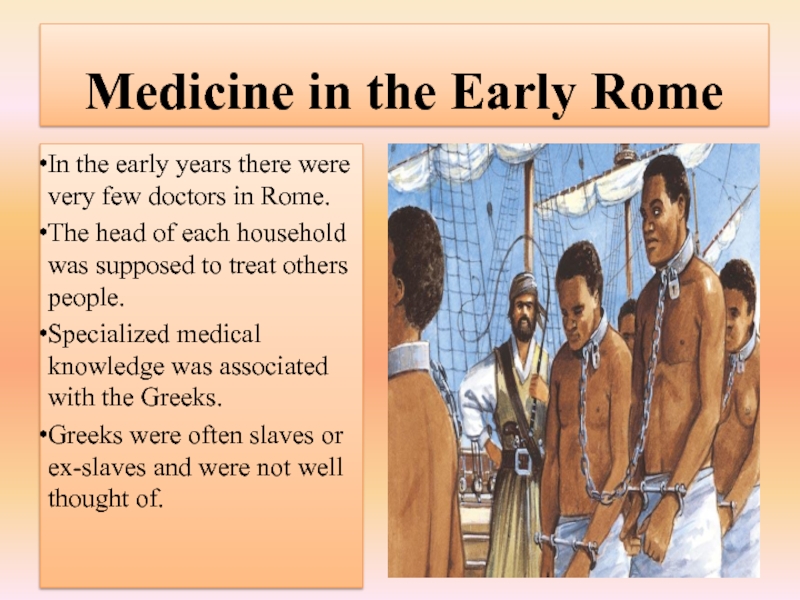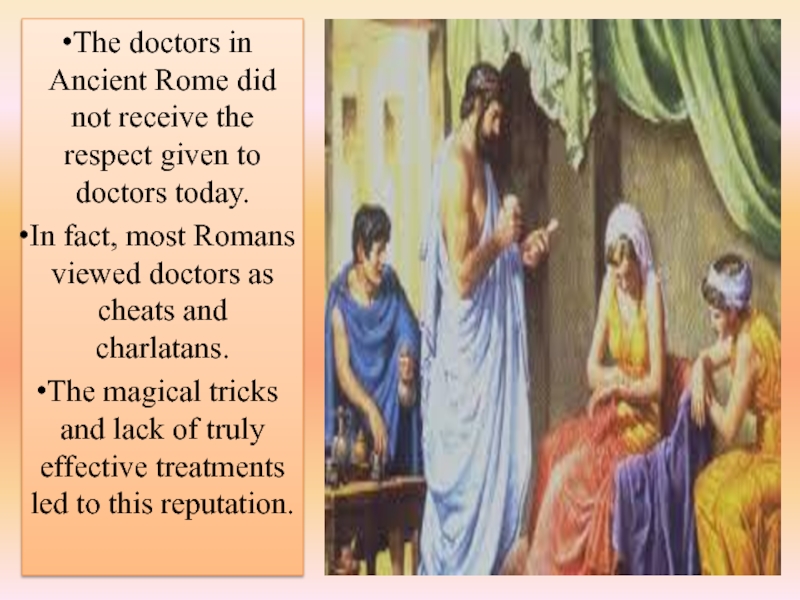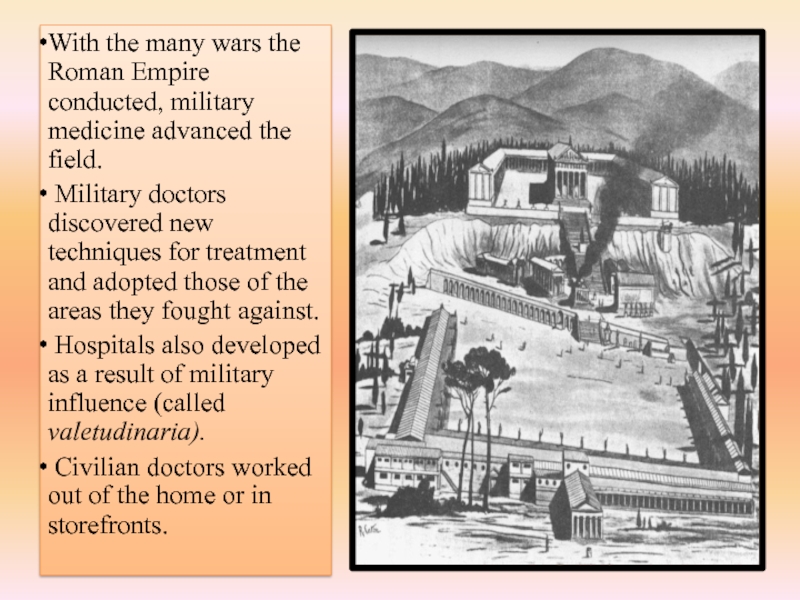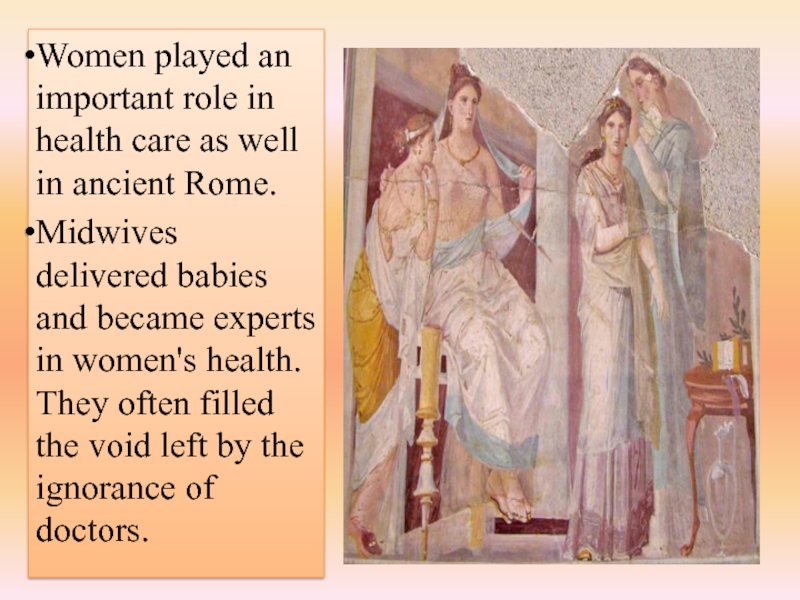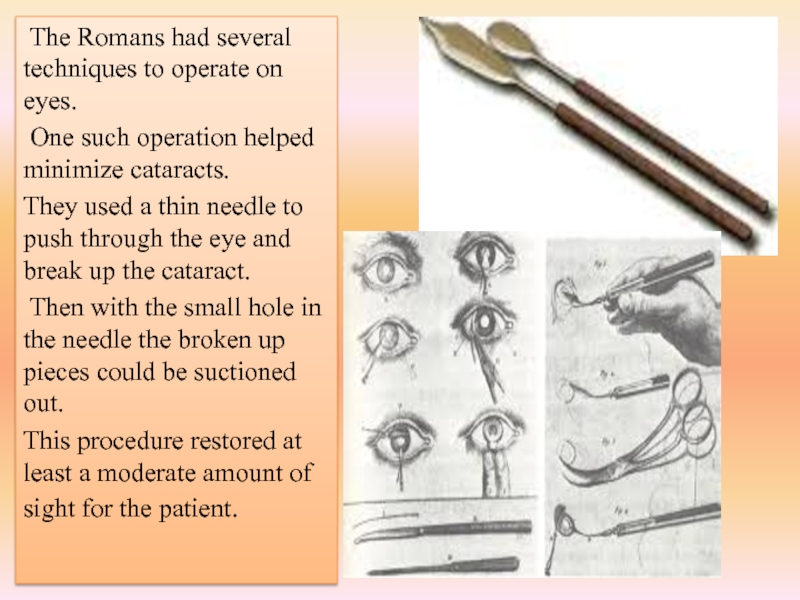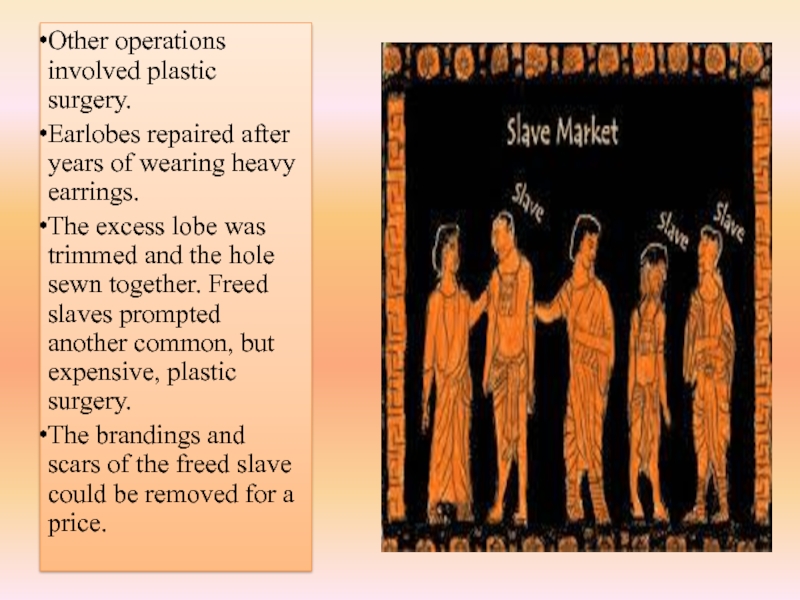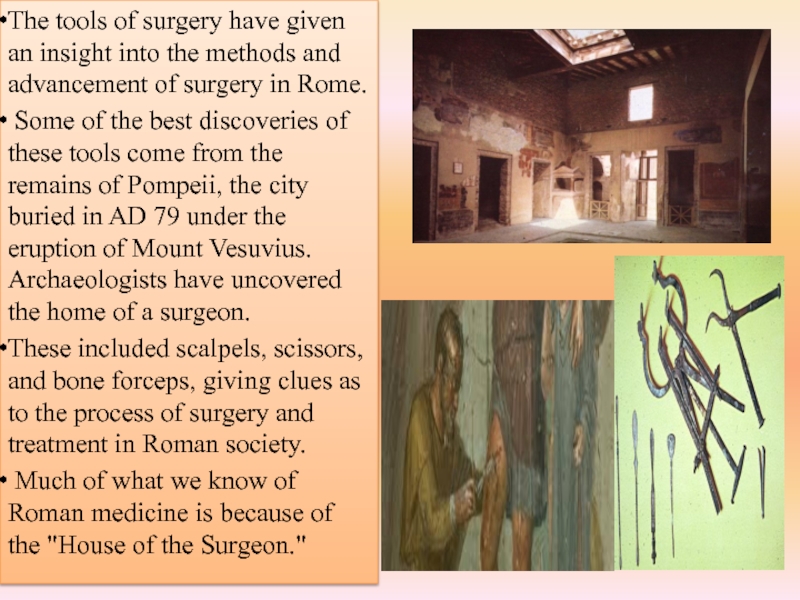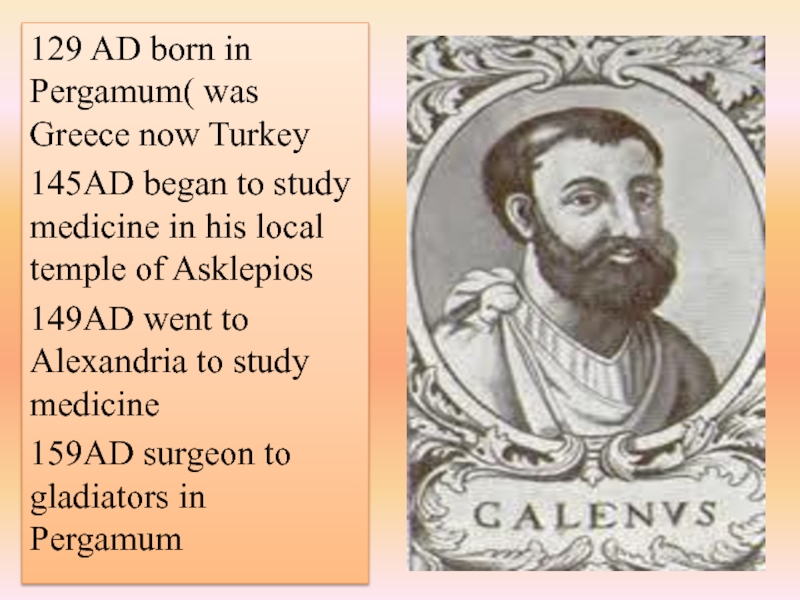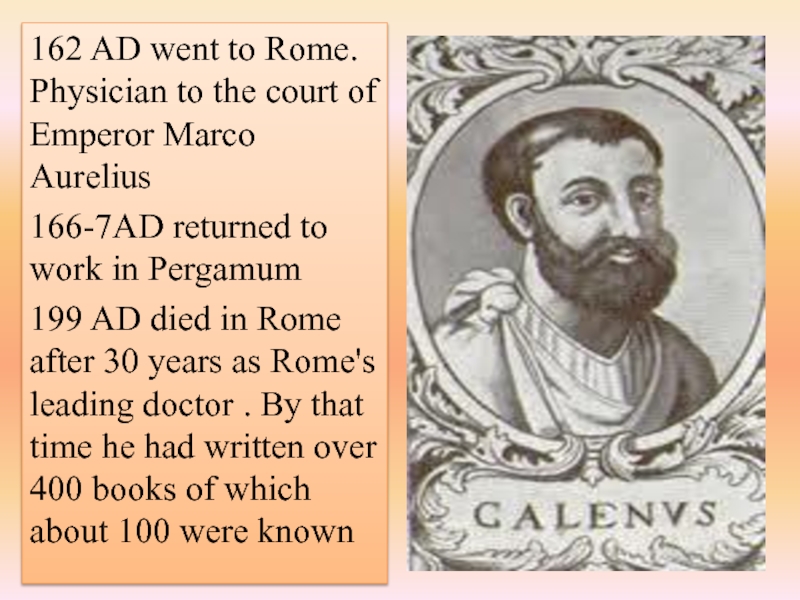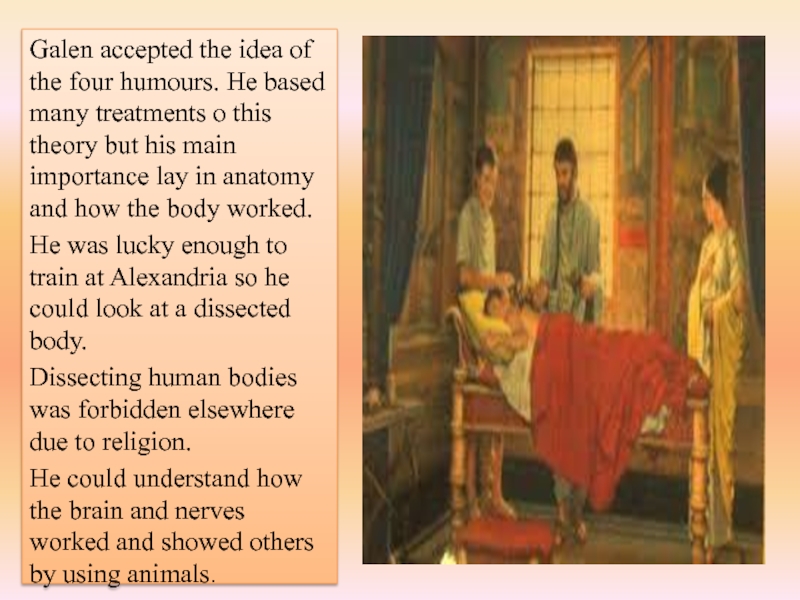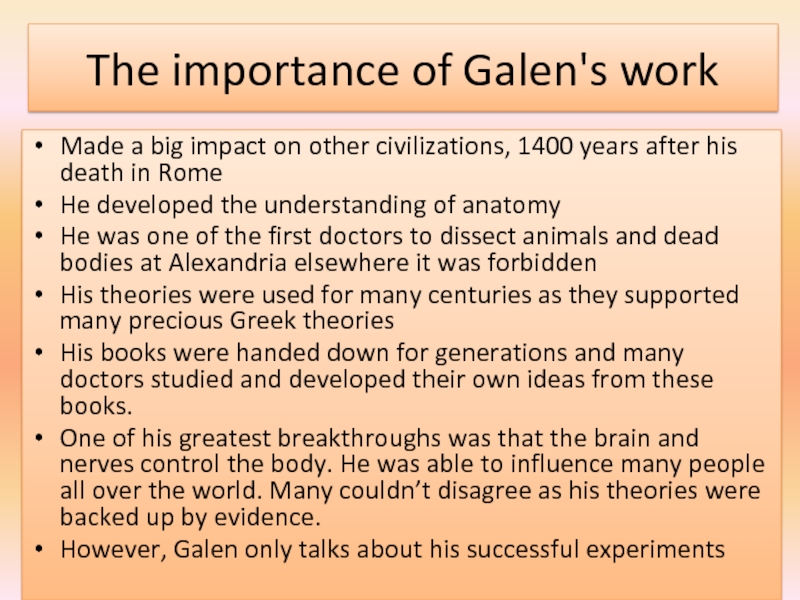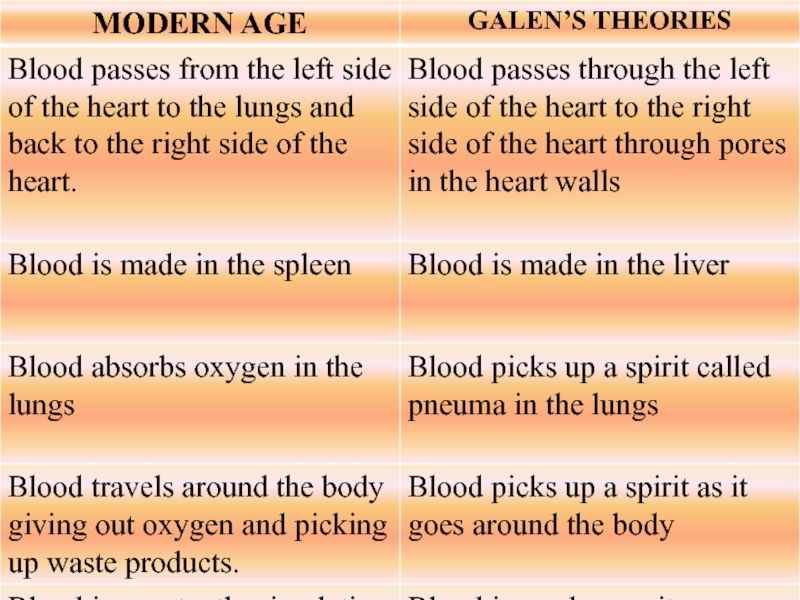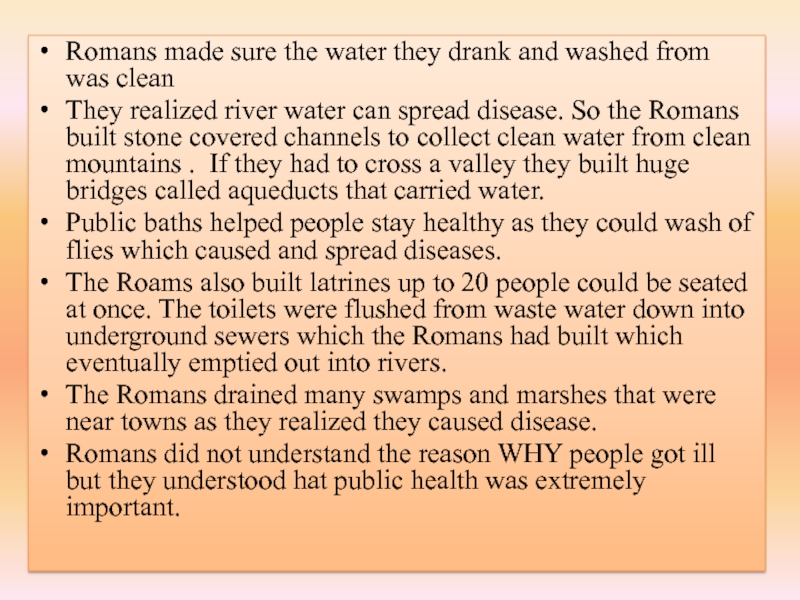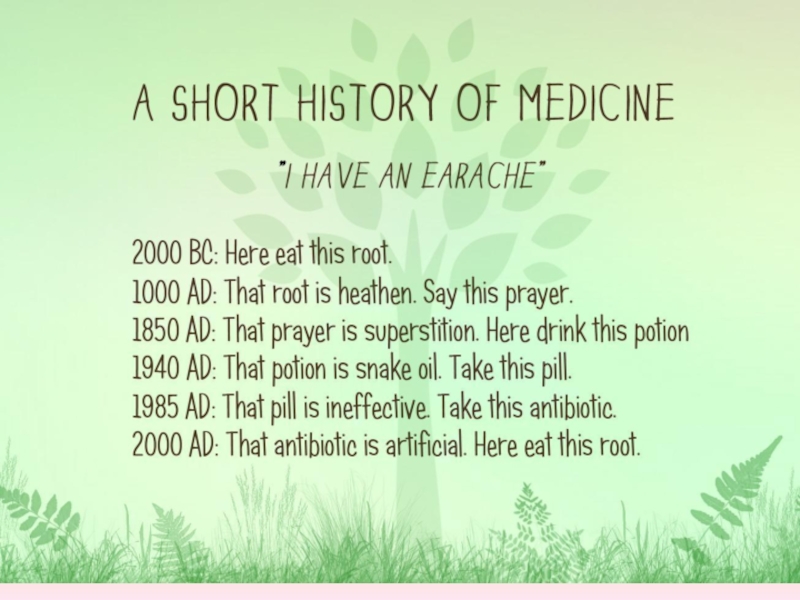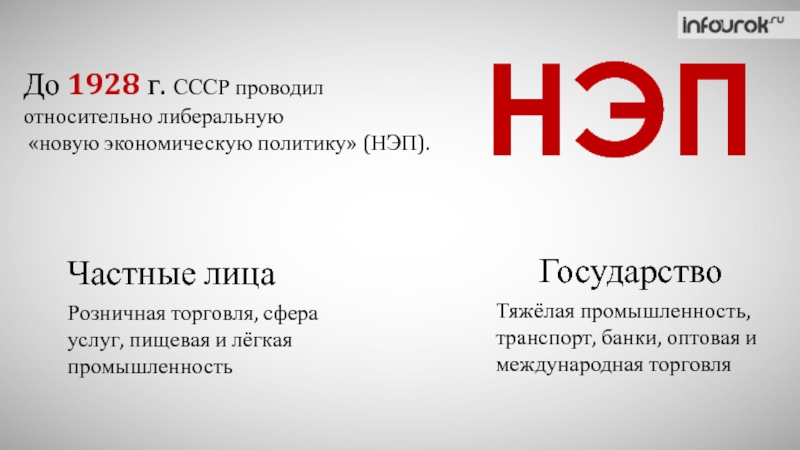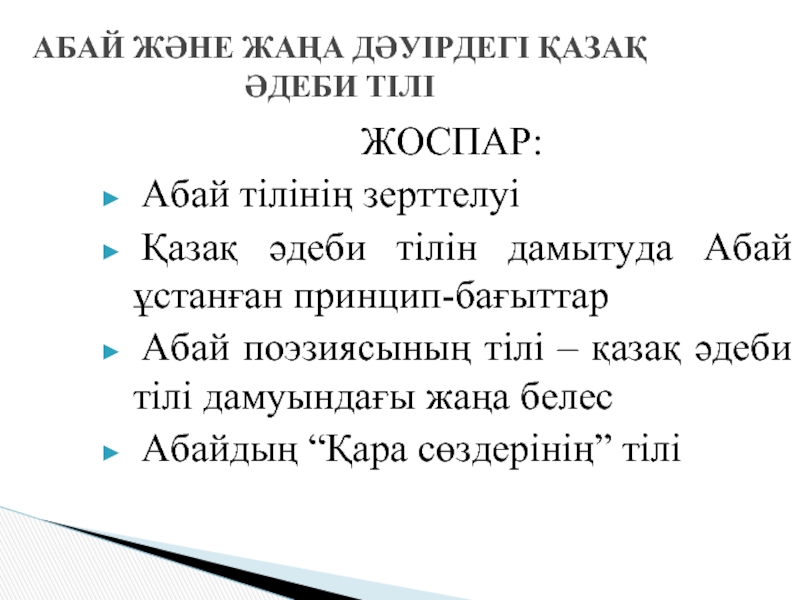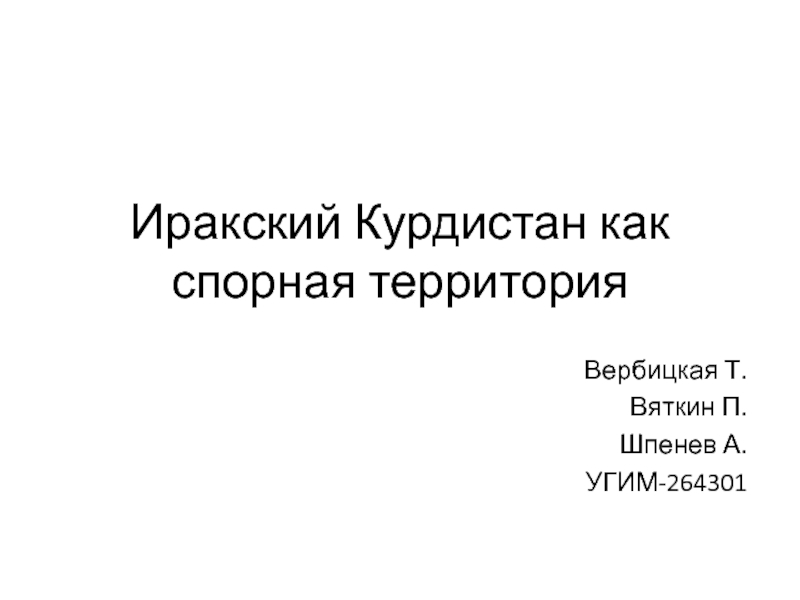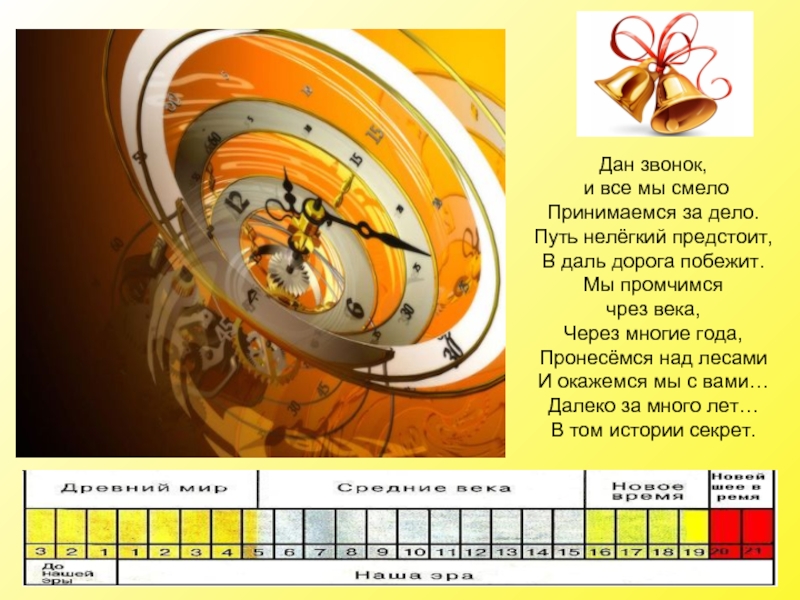O.S.
- Главная
- Разное
- Дизайн
- Бизнес и предпринимательство
- Аналитика
- Образование
- Развлечения
- Красота и здоровье
- Финансы
- Государство
- Путешествия
- Спорт
- Недвижимость
- Армия
- Графика
- Культурология
- Еда и кулинария
- Лингвистика
- Английский язык
- Астрономия
- Алгебра
- Биология
- География
- Детские презентации
- Информатика
- История
- Литература
- Маркетинг
- Математика
- Медицина
- Менеджмент
- Музыка
- МХК
- Немецкий язык
- ОБЖ
- Обществознание
- Окружающий мир
- Педагогика
- Русский язык
- Технология
- Физика
- Философия
- Химия
- Шаблоны, картинки для презентаций
- Экология
- Экономика
- Юриспруденция
Medicine of ancient Greece and Rome презентация
Содержание
- 1. Medicine of ancient Greece and Rome
- 2. PLAN. 1. Development of Greek civilization. 2.
- 3. As the Egyptian civilization faded, the Greek
- 4. Instead of growing into a large empire
- 5. The Greek states built up a wide
- 6. The Greeks developed the use of logic in discussion,
- 7. Why did things happen? Greek philosophers found rational reasons for
- 8. After 300BC Alexander the Great conquered a
- 9. The city built by Alexander in
- 10. After philosophers such as Aristotle and Plato
- 11. Surgeon Herophilus realised that the brain,
- 12. Greeks realised that prayers were useless against illnesses such
- 13. Idea that the human body consisted of
- 14. This gave Greek doctors their idea Pythagoras
- 15. Followers of Pythagoras, Pythagoreans, believed that numbers
- 16. Baby would enjoy better health if he/she
- 17. Hippocrates The most famous, and probably the
- 18. Hippocrates Hippocrates collected data and conducted experiments
- 19. Four Humors. "The body of man has
- 20. Hippocrates saw pepsis, or an orderly, balanced, harmonious digestion
- 21. Hippocrates' anatomical knowledge was poor, but compensated
- 22. HIPPOCRATES : Strengthening and building up
- 23. A CODE OF CONDUCT One of the
- 24. Greek surgery Greek doctors became experts at
- 25. Greek methods of diagnosis and treatment The
- 26. Irrational treatment When their doctors could not
- 27. Irrational treatment There they made offering or
- 28. Irrational treatment The snake is still the
- 29. MEDICINE OF ANCIENT ROME.
- 30. Roman civilization Ancient Rome was a flourishing
- 31. Roman civilization Roman civilization developed into a
- 32. Roman civilization Roman wealth went more into
- 33. Medicine in the Early Rome In the
- 34. The doctors in Ancient Rome did not
- 35. With the many wars the Roman Empire
- 36. Women played an important role in health
- 37. The Romans had several techniques to
- 38. Other operations involved plastic surgery. Earlobes
- 39. The tools of surgery have given an
- 40. 129 AD born in Pergamum( was Greece
- 41. 162 AD went to Rome. Physician to
- 42. Galen accepted the idea of the four
- 43. The importance of Galen's work Made
- 45. Romans made sure the water they drank
- 47. Thank you for your attention!
Слайд 2PLAN.
1. Development of Greek civilization.
2. Alexandria – centre of science and
medicine.
3. Rational ideas about diseases – theory of four humors.
4. Irrational ideas about treatment and diseases – asclepions.
5. Hippocrates – Father of Medicine.
6. Ancient Roman civilization.
7. Military medicine of Ancient Rome.
8. Galen – an outstanding anatomist and physician.
3. Rational ideas about diseases – theory of four humors.
4. Irrational ideas about treatment and diseases – asclepions.
5. Hippocrates – Father of Medicine.
6. Ancient Roman civilization.
7. Military medicine of Ancient Rome.
8. Galen – an outstanding anatomist and physician.
Слайд 3As the Egyptian civilization faded, the Greek one emerged around 700
BC. The Greek civilization prevailed until "the end of antiquity" around 600 AD.
Слайд 4Instead of growing into a large empire ruled by a monarch,
Greece developed as a number of city-states, ruled by a range of governments. Some of were democratic
(Athens), others were under dictatorships
(Macedon), others were ruled by
the military (Sparta).
(Athens), others were under dictatorships
(Macedon), others were ruled by
the military (Sparta).
Слайд 5The Greek states built up a wide trading empire. Greek cities
became immensely wealthy.
Cultural life - drama, comedy, sculpture, architecture, poetry, politics and public debates.
Phonetic form of writing - more flexible than Egyptian hieroglyphs.
Cultural life - drama, comedy, sculpture, architecture, poetry, politics and public debates.
Phonetic form of writing - more flexible than Egyptian hieroglyphs.
Слайд 6The Greeks developed the use of logic in discussion, and Aristotle used these
ideas to advance Greek understanding of mathematics. The teacher Socrates developed a new method of education, which involved asking questions.
Слайд 7Why did things happen?
Greek philosophers found rational reasons for things. Anaximander
(6th century BC) suggested that all matter was made up of 'elements' (earth, water, air and fire).
Illness, too, had a natural cause and if a natural cause, therefore a natural cure.
Illness, too, had a natural cause and if a natural cause, therefore a natural cure.
Слайд 8After 300BC Alexander the Great conquered a huge empire, and Greek
civilization and ideas spread all over the Middle East.
Слайд 9 The city built by Alexander in Egypt, Alexandria, became a centre
for study and learning, and was famous for its library.
Слайд 10After philosophers such as Aristotle and Plato decided that the human
body was not needed in the afterlife, Greek doctors at Alexandria in Egypt began to dissect bodies. Some even dissected the bodies of criminals who were still alive (vivisection).
Слайд 11 Surgeon Herophilus realised that the brain, not the heart, controls
the movement of the limbs.
Erasistratus discovered that the blood moves through the veins (although he did not realise that it circulated).
Thus a systematic way about the inside of the body.
Erasistratus discovered that the blood moves through the veins (although he did not realise that it circulated).
Thus a systematic way about the inside of the body.
Слайд 12Greeks realised that prayers were useless against illnesses such as the plague, and
that epilepsy was not caused by the gods. Hippocrates's book 'Airs, Waters and Places' suggested that disease was caused by the environment. Thus the way was open for an entirely natural theory of the cause of disease.
Слайд 13Idea that the human body consisted of the four humours, which
had to be kept in balance. This theory survived until after AD 1700.
Слайд 14This gave Greek doctors their idea Pythagoras came up with the
idea of the balance of opposites of the underlying cause of disease.
Слайд 15Followers of Pythagoras, Pythagoreans, believed that numbers had precise meanings, especially
the numbers 4 and 7.
and that 7x4 is the duration of the lunar month as well as the menstrual cycle (28 days),
7x40 is 280 which is how long a pregnancy is when it reaches full term.
and that 7x4 is the duration of the lunar month as well as the menstrual cycle (28 days),
7x40 is 280 which is how long a pregnancy is when it reaches full term.
Слайд 16Baby would enjoy better health if he/she was born on the
seventh month rather than the 8th.
The 40-day quarantine period to avoid disease contagion comes from the idea that the number forty is sacred.
The 40-day quarantine period to avoid disease contagion comes from the idea that the number forty is sacred.
Слайд 17Hippocrates
The most famous, and probably the most important medical figure in
Ancient Greece was Hippocrates, who is known today as "The Father of Medicine".
Слайд 18Hippocrates
Hippocrates collected data and conducted experiments to show that disease was
a natural process;
that the signs and symptoms of a disease were caused by the natural reactions of the body to the disease process;
that the chief role of the physician was to aid the natural resistance of the body to overcome the metabolic imbalance and restore health and harmony to the organism.
that the signs and symptoms of a disease were caused by the natural reactions of the body to the disease process;
that the chief role of the physician was to aid the natural resistance of the body to overcome the metabolic imbalance and restore health and harmony to the organism.
Слайд 19Four Humors. "The body of man has in itself blood, phlegm, yellow
bile, and black bile; these make up the nature of the body, and through these he feels pain or enjoys health. Now, he enjoys the most perfect health when these elements are duly proportioned to one another in respect to compounding, power and bulk, and when they are perfectly mingled. Pain is felt when one of these elements is in defect or excess, or is isolated in the body without being compounded with all the others."
Слайд 20Hippocrates saw pepsis, or an orderly, balanced, harmonious digestion and metabolism of the
Four Humors as being essential to all good health. In disorders of pepsis Hippocrates saw the origin of most disease.
Слайд 21 Hippocrates' anatomical knowledge was poor, but compensated by knowledge of physiology
and the soundness of his reasoning.
His surgical techniques for dislocations of the hip and jaw were unsurpassed until the 19 century.
His surgical techniques for dislocations of the hip and jaw were unsurpassed until the 19 century.
Слайд 22HIPPOCRATES :
Strengthening and building up the body's inherent resistance to
disease.
He prescribed gymnastics, exercise, massage, hydrotherapy and sea bathing.
He prescribed a very slender, light diet during the crisis stage of an acute illness, and a liquid diet during the treatment of fevers and wounds.
He prescribed gymnastics, exercise, massage, hydrotherapy and sea bathing.
He prescribed a very slender, light diet during the crisis stage of an acute illness, and a liquid diet during the treatment of fevers and wounds.
Слайд 23A CODE OF CONDUCT
One of the most significant achievements – idea
that doctors should follow a set of rules of behaviour. Hippocrates set out a Hippocratic Oath for doctors that outlined the way they should behave.
Слайд 24Greek surgery
Greek doctors became experts at practical first aid.
They also learned
about setting broken and dislocated bones
Greek doctors did not have anaesthetics, and only had herbal antiseptics - so successful surgical operations would have been extremely difficult for them to perform.
Greek doctors did not have anaesthetics, and only had herbal antiseptics - so successful surgical operations would have been extremely difficult for them to perform.
Слайд 25Greek methods of diagnosis and treatment
The Greek doctors made their medical
diagnosis based on examination of their patient from head to foot - this is called clinical observation.
The ancient Greeks came to understand that illness had natural causes, and could not be cured by appealing to their gods. They therefore looked for natural cures, using natural substances such as garlic, vinegar and honey.
Four humours:
They would cure a cold by keeping the patient warm.
They would treat a fever (hot and wet) by keeping the patient cool and dry.
They used bleeding and purging - not, as the Egyptians, to unblock a channel, but in order to rebalance two of the humours - the blood and the black bile.
The ancient Greeks came to understand that illness had natural causes, and could not be cured by appealing to their gods. They therefore looked for natural cures, using natural substances such as garlic, vinegar and honey.
Four humours:
They would cure a cold by keeping the patient warm.
They would treat a fever (hot and wet) by keeping the patient cool and dry.
They used bleeding and purging - not, as the Egyptians, to unblock a channel, but in order to rebalance two of the humours - the blood and the black bile.
Слайд 26Irrational treatment
When their doctors could not heal them, many Greeks still
appealed to their gods. Asklepios was the Greek god of healing.
The temples built for his worship were used for treating the sick - called an asklepion
The temples built for his worship were used for treating the sick - called an asklepion
Слайд 27Irrational treatment
There they made offering or sacrifice to the god.
Bathe in
the sea to cleanse and purify themselves.
After exercising and resting, and perhaps taking certain potions, patients slept the night in the holy place - called the abaton - of the temple.
Here the god and his daughters Hygeia and Panacea came with two holy snakes, and healed the patients.
After exercising and resting, and perhaps taking certain potions, patients slept the night in the holy place - called the abaton - of the temple.
Here the god and his daughters Hygeia and Panacea came with two holy snakes, and healed the patients.
Слайд 28Irrational treatment
The snake is still the symbol of chemists, and words hygiene and panacea have
become a part of our language.
Слайд 30Roman civilization
Ancient Rome was a flourishing civilization that started around 800
BC and existed for approximately 1200 years.
It started off in Rome, and grew into one of the largest and most powerful empires in ancient history.
The empire spread to Southern, Western and parts of Eastern Europe, Asia Minor and North Africa. In many ways, the Roman and Greek empires shared a number values and systems.
It started off in Rome, and grew into one of the largest and most powerful empires in ancient history.
The empire spread to Southern, Western and parts of Eastern Europe, Asia Minor and North Africa. In many ways, the Roman and Greek empires shared a number values and systems.
Слайд 31Roman civilization
Roman civilization developed into a massive empire, unlike the Greek
civilization which consisted of many small city-states.
The Roman empire was centralized; the emperor in Rome was all-powerful and wielded his power, will and laws throughout the empire.
The Roman empire was centralized; the emperor in Rome was all-powerful and wielded his power, will and laws throughout the empire.
Слайд 32Roman civilization
Roman wealth went more into practical projects and less into
culture and philosophy.
The Romans built aqueducts to pipe water to cites, sewers in their capital city, and public baths everywhere.
The Romans built aqueducts to pipe water to cites, sewers in their capital city, and public baths everywhere.
Слайд 33Medicine in the Early Rome
In the early years there were very
few doctors in Rome.
The head of each household was supposed to treat others people.
Specialized medical knowledge was associated with the Greeks.
Greeks were often slaves or ex-slaves and were not well thought of.
The head of each household was supposed to treat others people.
Specialized medical knowledge was associated with the Greeks.
Greeks were often slaves or ex-slaves and were not well thought of.
Слайд 34The doctors in Ancient Rome did not receive the respect given
to doctors today.
In fact, most Romans viewed doctors as cheats and charlatans.
The magical tricks and lack of truly effective treatments led to this reputation.
In fact, most Romans viewed doctors as cheats and charlatans.
The magical tricks and lack of truly effective treatments led to this reputation.
Слайд 35With the many wars the Roman Empire conducted, military medicine advanced
the field.
Military doctors discovered new techniques for treatment and adopted those of the areas they fought against.
Hospitals also developed as a result of military influence (called valetudinaria).
Civilian doctors worked out of the home or in storefronts.
Military doctors discovered new techniques for treatment and adopted those of the areas they fought against.
Hospitals also developed as a result of military influence (called valetudinaria).
Civilian doctors worked out of the home or in storefronts.
Слайд 36Women played an important role in health care as well in
ancient Rome.
Midwives delivered babies and became experts in women's health. They often filled the void left by the ignorance of doctors.
Midwives delivered babies and became experts in women's health. They often filled the void left by the ignorance of doctors.
Слайд 37 The Romans had several techniques to operate on eyes.
One
such operation helped minimize cataracts.
They used a thin needle to push through the eye and break up the cataract.
Then with the small hole in the needle the broken up pieces could be suctioned out.
This procedure restored at least a moderate amount of sight for the patient.
They used a thin needle to push through the eye and break up the cataract.
Then with the small hole in the needle the broken up pieces could be suctioned out.
This procedure restored at least a moderate amount of sight for the patient.
Слайд 38Other operations involved plastic surgery.
Earlobes repaired after years of wearing
heavy earrings.
The excess lobe was trimmed and the hole sewn together. Freed slaves prompted another common, but expensive, plastic surgery.
The brandings and scars of the freed slave could be removed for a price.
The excess lobe was trimmed and the hole sewn together. Freed slaves prompted another common, but expensive, plastic surgery.
The brandings and scars of the freed slave could be removed for a price.
Слайд 39The tools of surgery have given an insight into the methods
and advancement of surgery in Rome.
Some of the best discoveries of these tools come from the remains of Pompeii, the city buried in AD 79 under the eruption of Mount Vesuvius. Archaeologists have uncovered the home of a surgeon.
These included scalpels, scissors, and bone forceps, giving clues as to the process of surgery and treatment in Roman society.
Much of what we know of Roman medicine is because of the "House of the Surgeon."
Some of the best discoveries of these tools come from the remains of Pompeii, the city buried in AD 79 under the eruption of Mount Vesuvius. Archaeologists have uncovered the home of a surgeon.
These included scalpels, scissors, and bone forceps, giving clues as to the process of surgery and treatment in Roman society.
Much of what we know of Roman medicine is because of the "House of the Surgeon."
Слайд 40129 AD born in Pergamum( was Greece now Turkey
145AD began to
study medicine in his local temple of Asklepios
149AD went to Alexandria to study medicine
159AD surgeon to gladiators in Pergamum
149AD went to Alexandria to study medicine
159AD surgeon to gladiators in Pergamum
Слайд 41162 AD went to Rome. Physician to the court of Emperor
Marco Aurelius
166-7AD returned to work in Pergamum
199 AD died in Rome after 30 years as Rome's leading doctor . By that time he had written over 400 books of which about 100 were known
166-7AD returned to work in Pergamum
199 AD died in Rome after 30 years as Rome's leading doctor . By that time he had written over 400 books of which about 100 were known
Слайд 42Galen accepted the idea of the four humours. He based many
treatments o this theory but his main importance lay in anatomy and how the body worked.
He was lucky enough to train at Alexandria so he could look at a dissected body.
Dissecting human bodies was forbidden elsewhere due to religion.
He could understand how the brain and nerves worked and showed others by using animals.
He was lucky enough to train at Alexandria so he could look at a dissected body.
Dissecting human bodies was forbidden elsewhere due to religion.
He could understand how the brain and nerves worked and showed others by using animals.
Слайд 43The importance of Galen's work
Made a big impact on other
civilizations, 1400 years after his death in Rome
He developed the understanding of anatomy
He was one of the first doctors to dissect animals and dead bodies at Alexandria elsewhere it was forbidden
His theories were used for many centuries as they supported many precious Greek theories
His books were handed down for generations and many doctors studied and developed their own ideas from these books.
One of his greatest breakthroughs was that the brain and nerves control the body. He was able to influence many people all over the world. Many couldn’t disagree as his theories were backed up by evidence.
However, Galen only talks about his successful experiments
He developed the understanding of anatomy
He was one of the first doctors to dissect animals and dead bodies at Alexandria elsewhere it was forbidden
His theories were used for many centuries as they supported many precious Greek theories
His books were handed down for generations and many doctors studied and developed their own ideas from these books.
One of his greatest breakthroughs was that the brain and nerves control the body. He was able to influence many people all over the world. Many couldn’t disagree as his theories were backed up by evidence.
However, Galen only talks about his successful experiments
Слайд 45Romans made sure the water they drank and washed from was
clean
They realized river water can spread disease. So the Romans built stone covered channels to collect clean water from clean mountains . If they had to cross a valley they built huge bridges called aqueducts that carried water.
Public baths helped people stay healthy as they could wash of flies which caused and spread diseases.
The Roams also built latrines up to 20 people could be seated at once. The toilets were flushed from waste water down into underground sewers which the Romans had built which eventually emptied out into rivers.
The Romans drained many swamps and marshes that were near towns as they realized they caused disease.
Romans did not understand the reason WHY people got ill but they understood hat public health was extremely important.
They realized river water can spread disease. So the Romans built stone covered channels to collect clean water from clean mountains . If they had to cross a valley they built huge bridges called aqueducts that carried water.
Public baths helped people stay healthy as they could wash of flies which caused and spread diseases.
The Roams also built latrines up to 20 people could be seated at once. The toilets were flushed from waste water down into underground sewers which the Romans had built which eventually emptied out into rivers.
The Romans drained many swamps and marshes that were near towns as they realized they caused disease.
Romans did not understand the reason WHY people got ill but they understood hat public health was extremely important.
